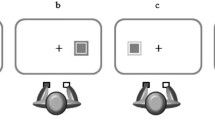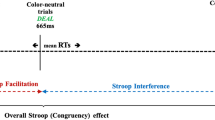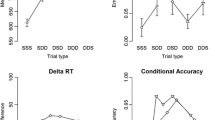Abstract
Stroop effects might be due to differences in stimulus-response compatibility (SRC) and/or to differences in stimulus-stimulus compatibility (SSC). Recent evidence for the role of SSC is inconclusive, because there were no controls for effects of SRC that are based on short-term associations between stimuli and responses (i.e., associations set up as the result of task instructions). In two experiments, SRC effects were controlled for. Regardless of whether the irrelevant and the relevant stimulus features were separated (Experiment 1) or integrated in one stimulus (Experiment 2), the results revealed an effect of SSC and an effect of SRC that was based on short-term associations. The results thus confirm that both processes at the level of encoding and processes at the level of response selection contribute to the Stroop effect.
Article PDF
Similar content being viewed by others
Avoid common mistakes on your manuscript.
References
Baddeley, A. D., &Hitch, G. J. (1974). Working memory. In G. H. Bower (Ed.),The psychology of learning and motivation (Vol. 8, pp. 47–90). New York: Academic Press.
Bovens, N., &Brysbaert, M. (1990). IBM PC/XT/AT and PS/2 Turbo Pascal timing with extended resolution.Behavior Research Methods, Instruments, & Computers,22, 332–334.
Cohen, J. D., Dunbar, K., &McClelland, J. L. (1990). On the control of automatic processes: A parallel distributed processing account of the Stroop effect.Psychological Review,97, 332–361.
Dalrymple-Alford, E. C., &Azkoul, J. (1972). The locus of interference in the Stroop and related tasks.Perception & Psychophysics,11, 385–388.
De Houwer, J. (2003). A structural analysis of indirect measures of attitudes. In J. Musch & K. C. Klauer (Eds.),The psychology of evaluation: Affective processes in cognition and emotion (pp. 219–244). Mahwah, NJ: Erlbaum.
De Houwer, J. (in press). Spatial Simon effects with non-spatial responses.Psychonomic Bulletin & Review.
Eriksen, B. A., &Eriksen, C. W. (1974). Effects of noise letters upon the identification of a target letter in a nonsearch task.Perception & Psychophysics,16, 143–149.
Eriksen, C. W. (1995). The flankers task and response competition: A useful tool for investigating a variety of cognitive problems.Visual Cognition,2, 111–118.
Glaser, W. R., &Glaser, M. O. (1989). Context effects in Stroop-like word and picture processing.Journal of Experimental Psychology: General,118, 13–42.
Hock, H. S., &Egeth, H. (1970). Verbal interference with encoding in a perceptual classification task.Journal of Experimental Psychology,83, 299–303.
Kornblum, S., Hasbroucq, T., &Osman, A. (1990). Dimensional overlap: Cognitive basis for stimulus-response compatibility. A model and taxonomy.Psychological Review,97, 253–270.
Levy, B. A. (1971). The role of articulation in auditory and visual shortterm memory.Journal of Verbal Learning & Verbal Behavior,10, 123–132.
Lu, C.-H., &Proctor, R. W. (1995). The influence of irrelevant location information on performance: A review of the Simon and spatial Stroop effects.Psychonomic Bulletin & Review,2, 174–207.
MacLeod, C. M. (1991). Half a century of research on the Stroop effect: An integrative review.Psychological Bulletin,109, 163–203.
Proctor, R. W., &Vu, K.-P. L. (2002). Eliminating, magnifying, and reversing spatial compatibility effects with mixed location-relevant and irrelevant trials. In W. Prinz & B. Hommel (Eds.),Common mechanisms in perception and action: Attention and performance XIX (pp. 443–473). Oxford: Oxford University Press.
Simon, J. R. (1990). The effects of an irrelevant directional cue on human information processing. In R. W. Proctor & T. G. Reeve (Eds.),Stimulus-response compatibility: An integrated perspective (pp. 31–86). Amsterdam: Elsevier, North-Holland.
Stroop, J. R. (1935). Studies of interference in serial verbal reactions.Journal of Experimental Psychology,18, 643–662.
Tagliabue, M., Zorzi, M., Umiltà, C., &Bassignani, F. (2000). The role of long-term-memory and short-term-memory links in the Simon effect.Journal of Experimental Psychology: Human Perception & Performance,26, 648–670.
Virzi, R. A., &Egeth, H. E. (1985). Toward a translational model of Stroop interference.Memory & Cognition,13, 304–319.
Zhang, H., &Kornblum, S. (1998). The effects of stimulus-response mapping and irrelevant stimulus-response and stimulus-stimulus overlap in four-choice Stroop tasks with single-carrier stimuli.Journal of Experimental Psychology: Human Perception & Performance,24, 3–19.
Zhang, H., Zhang, J., &Kornblum, S. (1999). A parallel distributed processing model of stimulus-stimulus and stimulus-response compatibility.Cognitive Psychology,38, 386–432.
Author information
Authors and Affiliations
Corresponding author
Rights and permissions
About this article
Cite this article
De Houwer, J. On the role of stimulus-response and stimulus-stimulus compatibility in the Stroop effect. Memory & Cognition 31, 353–359 (2003). https://doi.org/10.3758/BF03194393
Received:
Accepted:
Issue Date:
DOI: https://doi.org/10.3758/BF03194393




